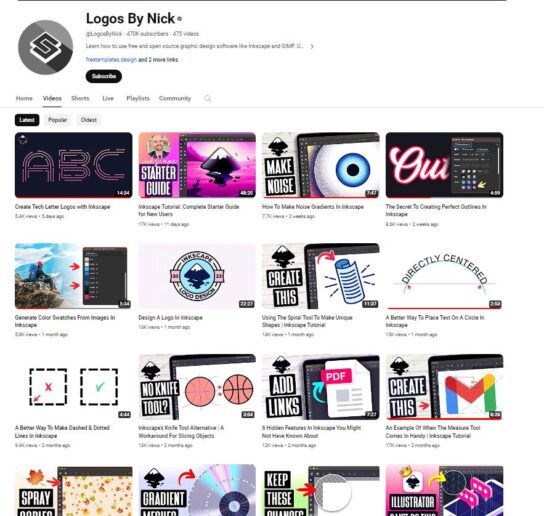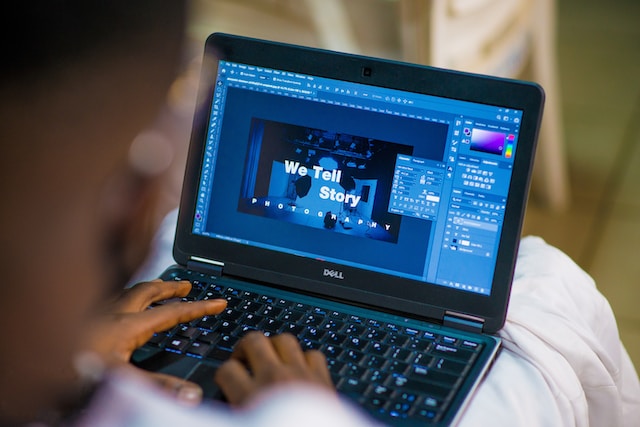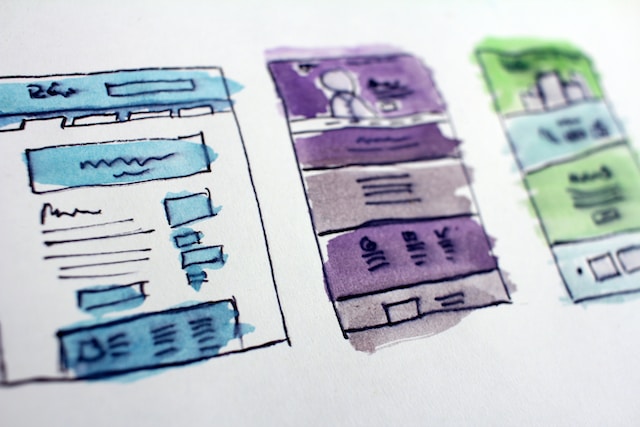You want to transition into graphic design.
Maybe you’re burnt out after years of the corporate grind, or maybe the career you chose when you finished high school just doesn’t fit your lifestyle anymore.
Maybe you’re reaching retirement age, but want to keep your mind sharp and keep regular paychecks coming in.
Maybe you want to earn money doing something creative.
So:
How do you transition to a graphic design career?
To transition to a graphic design career, follow a structured learning path that includes design principles, software proficiency, and portfolio building. You don’t need a design degree to become a graphic designer and you can learn from home with the right resources.
MY NEW ONLINE COURSE
Thinking Like a Designer
Learn my proven method to finally understand the rules of any design and jumpstart your path to become an effective graphic designer

To transition to a graphic design career, follow these steps:
- Understand why you want to transition
- Learn graphic design theory
- Learn graphic design software
- Find small projects
- Build your portfolio
- Build non-designer skills
- Learn how to freelance
- Start your transition
Whatever your motivation for changing careers, the first step in making that transition is understanding the career transition process.
For somebody transitioning to a graphic design career, it’s a self-paced, often inexpensive transition.
You don’t need to earn a degree or pass any kind of certification exam; all you need is creativity and a computer. In fact, it’s even possible to get into graphic design with no experience.
Let’s look at the steps to make a career change to graphic design in more detail.
1. Understand Why You Want to Transition
Before we get into how to transition to a graphic design career, let’s talk about whether pursuing a graphic design career is a good career change for you.
Whether graphic design is a good career choice depends on several factors.
A good way to gauge if graphic design is a good career change is to look at what it involves and answer a few honest questions about yourself, your skills, and your work style.
Ask yourself:
- Do I want another office job, or would I prefer to be self-employed?
- Do I have the patience and determination to learn a new skill set?
- Am I self-motivated enough to learn that new skill set on my own?
2. Learn Graphic Design Theory
One of the most important actions toward transitioning to a graphic design career is learning graphic design principles.
You can pursue a traditional graphic design education through a college or vocational school, or you can chart your own educational path through educational videos, blog posts, and online lessons.
No matter which path you pick, or if you mix and match, the goal is to cultivate a solid understanding of graphic design theory.
Start by learning the principles of design, like unity, hierarchy, balance, space, and totality. When you understand these principles as the fundamentals of design, you’re able to understand the “why” behind design choices in the logos and graphics you see every day.
You also automatically start applying this understanding to the designs you create, both as part of tutorials on specific design techniques and those you create on your own.
3. Learn Graphic Design Software
Learning graphic design software is super important. Play around in graphic design programs like Adobe Illustrator and Inkscape to get a feel for these software tools and start working out your creative muscles.
However:
It’s second to learning graphic design theory.
In fact:
Many aspiring graphic designers mistakenly start to learn software tricks thinking that this is the most important aspect of design.
Think about it: For a very long time, graphic design was done manually, without computers.
That said, you should start practicing with graphic design software early in your journey. Today, this is possible because there are many resources available to you, free of charge.
For example, there’s free and powerful graphic design software such as Inkscape or Gimp.
Also:
YouTube has high-quality tutorials for learning any graphic design software, including free and paid programs such as Adobe Illustrator, Photoshop, and InDesign. These tutorials show you step-by-step how to use the tools, and they cater to beginners but also to more advanced learners.
For example, channels like Logos by Nick or Davies Media Design are high-quality, serious learning resources you can stick to, all for free.

Try making different things like logos, posters, and business cards. This helps you understand what you’re learning and get better at using the software.
Challenge yourself with these different formats. Logos need to be simple and precise, posters tell stories with pictures, and business cards need to layout and clear communication.
So:
Learn the software, practice design theory as you learn, and try different kinds of designs.
But remember:
It’s not just about learning the tools. You’ve got to practice design theory while you’re learning the software.
4. Find Small Projects
Small projects are really important for making the transition into graphic design.
Why?
They’re vital for hands-on experience that allow you to apply design skills and principles in real scenarios.
But here’s the bonus:
These projects do more than just practice. They’re the building bricks for your portfolio. Each completed project or exercise adds to your growing body of work.
Plus, projects allow you to evolve. You practice, experiment, and refine. With each project, you sharpen your skills and carve out your unique design style.
By immersing yourself in projects and exercises, you forge a foundation for more important projects down the road.

As you build on these initial pieces, your portfolio gains depth and diversity, becoming visual validation to your capabilities, which will help you attract potential clients or employers.
How do you find these initial projects?
Start by asking friends or family members if they need graphic design help.
Graphic design is such a valuable skill these days that most of us are in constant need of logos, banners, ads, or promotions.
For example, does a friend need an ad or poster for a garage sale? Do they need help with their social media visual identity or YouTube thumbnail?
Furthermore:
There might be a need in your current job to create a poster for the next company barbecue or to revamp the email newsletter template.
There are many opportunities to do graphic design if you get creative; you just have to put yourself out there.
5. Build Your Graphic Design Portfolio
The next step to transitioning to a graphic design career is building your design portfolio.
As you learn design principles and become proficient in graphic design software, keep your finished work in a centralized, easy-to-share location. You can host this collection on a website, on your hard drive, or in the cloud.

Make that collection easy to share with prospective clients and employers. This is because when an individual or company hires a graphic designer, they want to see that designer’s portfolio to assess their skills and get to know their style.
The important thing is to build up a solid body of work long before you start connecting with prospective employers.
You can gamify this for yourself by committing to completing one design each day, or five designs per week—however many you can personally handle.
Your primary goal here isn’t quantity, but consistency. Get into the habit of designing regularly, because as a working designer, that’s what you’ll be doing.
6. Build Non-Design Designer Skills
While your portfolio might land you jobs, your non-design skills will keep you employed.
These are the soft skills that are necessary in any workplace, like interpersonal communication and responsibility.
They’re also business skills, like marketing yourself effectively and, if you choose to become a self-employed designer, lead generation and managing existing clients.
As you develop your design skills through tutorials and practice, develop your business skills through mentorship and coaching.
There are lots of beginner business courses available online, and you can probably find in-person coaching and business workshops in your community.
Don’t neglect this side of your skills development, even if you plan to pursue in-house graphic design jobs. Even traditionally employed individuals rely on entrepreneurial skills to advance their careers, and for creatives, this is often particularly true.
7. Learn How to Freelance
While there are plenty of in-house graphic design jobs out there, there are just as many self-employed graphic designers.
Moreover:
Today, many graphic designers make a successful living being their own bosses and having their own graphic design businesses.
You could land an in-house graphic design job, but chances are that, as you transition to a graphic design career, you will likely begin as a freelancer, taking on odd jobs as you build your skills and portfolio.
Many graphic designers make a successful living being their own bosses and having their own graphic design businesses
In fact, there are different ways of freelancing and making money as a graphic designer.
While platforms such as Fiverr or 99Designs are well-known places for freelancing, you could also go “old school” and send out intention letters offering your services to local businesses, such as restaurants or mom-and-pop shops.
Graphic design is in such demand that you might get a few projects by just offering your services.
8. Start Your Transition into a Graphic Design Career
One of the greatest aspects of graphic design as a second career is that you can start the transition process before you leave your previous career.
If you’re currently working full time, build a few hours of graphic design education into your week. Commit to designing after hours and on weekends.
This way, you can continue to earn an income while preparing to make graphic design your part-time or full-time career.
You might even start earning money through freelance jobs before you leave your current role.
Or:
You might decide that part-time freelance work is the perfect amount of design work for you, and choose to stay employed while taking on projects as you see fit.
When you aren’t relying on graphic design to pay your bills, you have the freedom to pick and choose projects based on how much they interest you.
However, the most important aspect is to fully understand what a transition is: A gradual change that takes time.
As I replied to Travis, one of my readers in his 40s, changing careers is not an On/Off switch.
If you start with the transition right now, at first maybe for the pleasure of learning something new and having a creative outlet, but as you continue other things might start to happen, like getting paid for your first design work.
If you commit to the process with dedication and patience, you will build the experience and body of work that will help you to actually transition.
So, start your transition right now, gradually but steadily.
Do You Need a Degree for a Career Switch to Graphic Design?
Graphic design, like any other profession, requires a specific skill set.
In this field, that skill set includes creativity, technical design skills, and proficiency in graphic design programs like Photoshop or Illustrator.
One important question is:
Are you ready to learn new skills?
Learning new skills can be challenging, and determining the right approach to learn these skills will determine your likelihood of success.
For example:
Do you tend to learn best in a formal classroom setting, or can you teach yourself new skills?
There’s nothing wrong with pursuing a graphic design degree, but keep in mind they can be expensive and can add many months or years to your transition timeline.
In general, I believe you don’t need a degree to be a graphic designer.
Personally, I truly believe that self-learning graphic design is completely feasible and, most importantly, can shorten how long it takes you to become a graphic designer, if you play it right.
In fact, I learned graphic design on my own to enhance my own career, and it was one of the best decisions I’ve made (learn more about my story).
There are lots of free and inexpensive resources online that you can use to teach yourself graphic design.
Graphic design books, for example, can be an excellent tool to learn graphic design theory. Also, there are many high-quality, self-paced graphic design courses to help you further your skills and knowledge.
Start Your Career Switch to Graphic Design
Nobody ever said starting a new career would be easy. But as Theodore Roosevelt said, “Nothing in the world is worth having or worth doing unless it means effort, pain, difficulty.”
If your goal is to become a professional graphic designer, that goal is within reach if you’re willing to work to develop your skills and push yourself to build connections—and if you’re patient.
Remember, this is a slow process, so don’t expect to be making six figures as a designer overnight. But it’s also a very accessible process.
Unlike career paths that require advanced degrees or long apprenticeships, graphic design is an accessible career for people coming from just about any field. You just need to be willing to learn how to do it.
Start right now with your transition. You will not regret it.
MY NEW ONLINE COURSE
Thinking Like a Designer
Learn my proven method to finally understand the rules of any design and jumpstart your path to become an effective graphic designer


